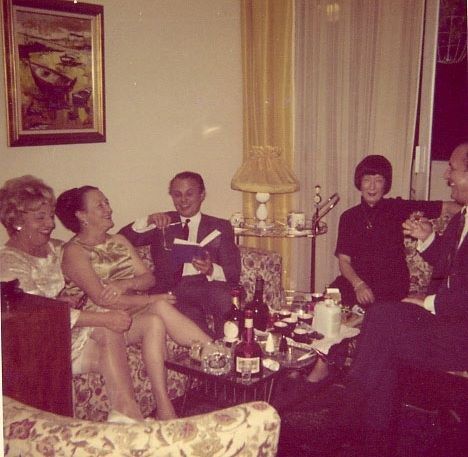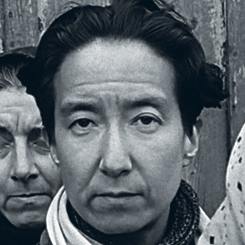The Mysterious Prisoner
- By Guest blogger
- 25 January, 2016
- No Comments
This website previously carried an article on Nadine Hwang (above in post-war photo from Venezuela, second from right), the mysterious Chinese prisoner of Nazi Germany’s Ravensbrück concentration camp. Much remains unknown about Hwang’s life story, but now interesting new information about her postwar fate has emerged and been published on the website Every Face Has a Name (click here for the website and here for the Facebook page). We carry the story with the kind permission of that website.
Born in Madrid, Spain in 1902. Nadine Hwang was the daughter of a Chinese diplomat father and a Belgian mother. She grew up in the upper class of both China and Spain. She trained to be a lawyer and was stationed as an honorary colonel in the Chinese army in 1920, during the Civil War. When Nadine was 35 years old, she moved to Paris and became the mistress of the well-known author Natalie Clifford Barney. Their circle included intellects and artists of the 1930’s Salon society such as Pablo Picasso, Federico Garcia Lorca and Jean Cocteau.
For unknown reasons Nadine was deported to the concentration camp Ravensbrück in 1944. There she became a friend of Rachel Krausz and her 9-year-old daughter Irene. Nadine helped them to get on the White Bus transport to Sweden. Nadine arrived in Malmö on April 28, 1945, together with Rachel and Irene. They stayed at the Malmöhus museum, which was used as quarantine for refugees at the time. Many years later when Irene had her own daughter she named her after Nadine.
Nadine’s face is one of the most recognisable in the films ‘Every Face Has a Name’ and ‘Harbour of Hope’, Many people have been wondering who this mysterious woman was and what happened to her after the arrival in Malmö.
Until recently our investigation into her enigmatic persona seemed to have come to a standstill. A document from the Chinese Legation in Stockholm states that Nadine left Sweden for China. She disappeared without a trace. After many years of searching for more clues we were contacted by a woman in Paris, Alexandra Lovera, whose father Jose Rafael had got to know Nadine in Caracas, Venezuela. She had actually looked after Alexandra as a baby during the 60s. Jose Rafael Lovera recollects:
“I first met Nadine in the early 1960s. She was working as a secretary at a bank in Venezuela. Soon after meeting her I realised that Nadine was a highly cultured and educated person who had fluently mastered several languages including Spanish, English and French. I also knew that she was a Law graduate and often heard her boss and other colleagues praise her special expertise.”
After her release from Ravensbrück, Nadine passed through Scandinavia to Brussels. There she met a relative on her mother’s side of the family who had a daughter; Claire Mousset, who had participated in the resistance under the name Nelly Voss. The two lived together in Brussels but the horrors of the Second World War, of which they were both victims along with the outbreak of war in Vietnam drove them to search for a new destination. Miss Mousset worked at the Embassy of Venezuela in Brussels and due to the country’s favourable status as a nation at peace they thought it would be a suitable destination.
“When I met Nadine she was already settled in Venezuela. She and Claire often invited groups of friends, amongst others my wife and I. The Consul General of France and his wife, and the fashion designer Guy Meliet, were also part of this group. In their new home Nadine and Claire hosted a New Year’s dinner at which my wife and I took some photographs.”
Jose Rafael recalls other stories from the war that Nadine had confided in him. She had always been interested in the military and had even learned to fly aeroplanes. During her time in Paris she had socialised with many prominent figures including Gertrude Stein and T.S. Eliot. At the Ravensbrück concentration camp she had been hospitalised and during that time overheard many delicate issues discussed between the army officers and Nazi Gestapo. She also recounted having met the young Mao whom her father had helped with an economic matter.
“Nadine was an excellent cook and she had a special grace; I remember a Chinese dance which she performed on one occasion with such delicate movements. Her outstanding intelligence and impressive talents were other powerful characteristics of her personality.”
Early signs of baldness were a great concern for Nadine and forced her into wearing a wig. She was prescribed a strong medication and suffered a stroke before completing the treatment. This diminished her capabilities considerably and forced her and Claire to return to Brussels. Jose Rafael and his wife visited them there one last time before Nadine died shortly after.
The reasons behind Nadine’s capture and her detainment at the concentration camp remain unclear but the discovery of a lost shoebox by Alexandra, containing photographs and letters, including correspondence with a Gestapo officer, have shed new light on the case.
“When I was a teen I found a box with some of her belongings (letters, photos etc). At the time it was tabu to talk of her sexuality so most unfortunately my parents got rid of the box. I managed to read some of the letters, the ones in English and French. The others were in German. I remember there was one picture of her with a young man, both of them in what seemed German military attire.”
Rumours suggest that Nadine may have been working as a spy, but there is no concrete proof.





 Copyright © 2025
Copyright © 2025
Leave a Reply